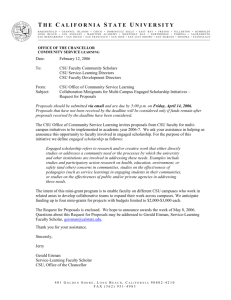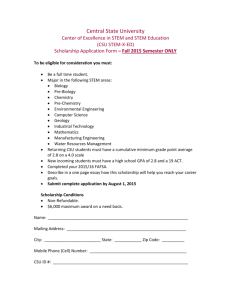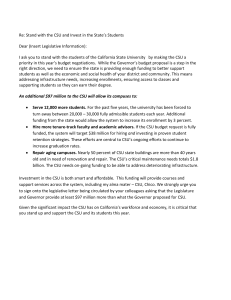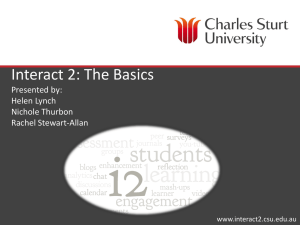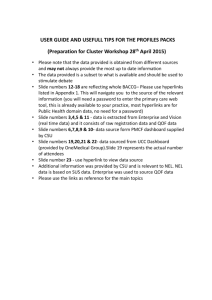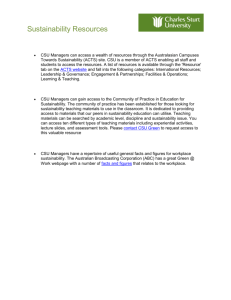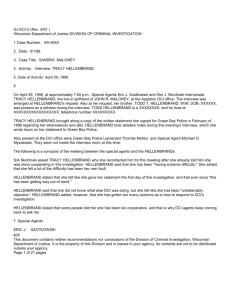Assessing the Costs and Benefits Associated with Research
advertisement
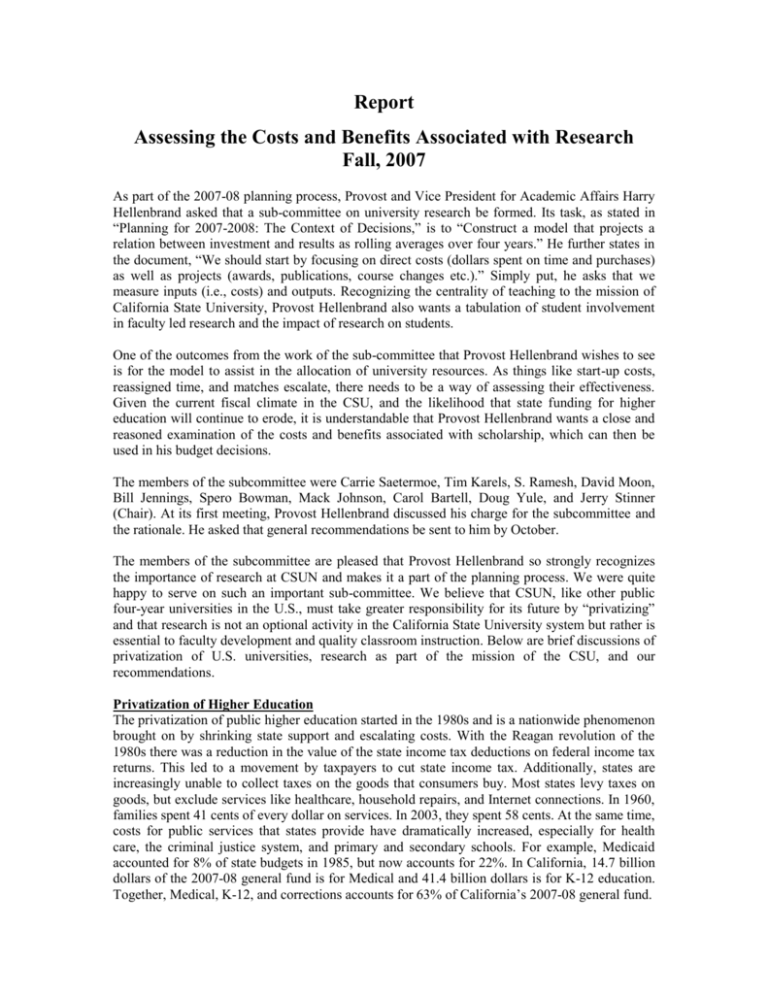
Report Assessing the Costs and Benefits Associated with Research Fall, 2007 As part of the 2007-08 planning process, Provost and Vice President for Academic Affairs Harry Hellenbrand asked that a sub-committee on university research be formed. Its task, as stated in “Planning for 2007-2008: The Context of Decisions,” is to “Construct a model that projects a relation between investment and results as rolling averages over four years.” He further states in the document, “We should start by focusing on direct costs (dollars spent on time and purchases) as well as projects (awards, publications, course changes etc.).” Simply put, he asks that we measure inputs (i.e., costs) and outputs. Recognizing the centrality of teaching to the mission of California State University, Provost Hellenbrand also wants a tabulation of student involvement in faculty led research and the impact of research on students. One of the outcomes from the work of the sub-committee that Provost Hellenbrand wishes to see is for the model to assist in the allocation of university resources. As things like start-up costs, reassigned time, and matches escalate, there needs to be a way of assessing their effectiveness. Given the current fiscal climate in the CSU, and the likelihood that state funding for higher education will continue to erode, it is understandable that Provost Hellenbrand wants a close and reasoned examination of the costs and benefits associated with scholarship, which can then be used in his budget decisions. The members of the subcommittee were Carrie Saetermoe, Tim Karels, S. Ramesh, David Moon, Bill Jennings, Spero Bowman, Mack Johnson, Carol Bartell, Doug Yule, and Jerry Stinner (Chair). At its first meeting, Provost Hellenbrand discussed his charge for the subcommittee and the rationale. He asked that general recommendations be sent to him by October. The members of the subcommittee are pleased that Provost Hellenbrand so strongly recognizes the importance of research at CSUN and makes it a part of the planning process. We were quite happy to serve on such an important sub-committee. We believe that CSUN, like other public four-year universities in the U.S., must take greater responsibility for its future by “privatizing” and that research is not an optional activity in the California State University system but rather is essential to faculty development and quality classroom instruction. Below are brief discussions of privatization of U.S. universities, research as part of the mission of the CSU, and our recommendations. Privatization of Higher Education The privatization of public higher education started in the 1980s and is a nationwide phenomenon brought on by shrinking state support and escalating costs. With the Reagan revolution of the 1980s there was a reduction in the value of the state income tax deductions on federal income tax returns. This led to a movement by taxpayers to cut state income tax. Additionally, states are increasingly unable to collect taxes on the goods that consumers buy. Most states levy taxes on goods, but exclude services like healthcare, household repairs, and Internet connections. In 1960, families spent 41 cents of every dollar on services. In 2003, they spent 58 cents. At the same time, costs for public services that states provide have dramatically increased, especially for health care, the criminal justice system, and primary and secondary schools. For example, Medicaid accounted for 8% of state budgets in 1985, but now accounts for 22%. In California, 14.7 billion dollars of the 2007-08 general fund is for Medical and 41.4 billion dollars is for K-12 education. Together, Medical, K-12, and corrections accounts for 63% of California’s 2007-08 general fund. Caught in the squeeze, states have been forced to make deep cuts in expenditures. Funding for higher education is discretionary; it receives what is left over after other budget decisions have been made. The result is that it is used to cover deficits in other areas. In 1980, 10% of state budgets went to higher education, but had fallen to 7% in 2000. In 1970, CSU and UC combined received 7% of the state’s general fund, but now receive 3.5%. From 2002 to 2004 alone, state governments cut higher education appropriations by almost 10% after inflation. From 2002 to 2005, appropriations for CSU were cut by $522MM. As a result, in many four-year public institutions state funding has fallen below 20% of their total revenue. In 1980, 44% of a student’s education at a public institution was covered by the state. In 2003 only 32% was. Cost cutting by public institutions has resulted in higher student-to-faculty ratios, from 17.3 in 1971 to 15.7 in 1997. For the CSU over the same time interval, student-tofaculty ratio increased from 18 to 20. But even more dramatic has been the effect upon tenuretrack faculty hires. Between 1995 and 2003, 2,450 tenured positions disappeared nationwide. In 1975, 43% of faculty positions were non-tenure-track (Instructors and part-time), compared with 58% in 1995, and 65% in 2003. From 1980 to 2003, ftes in the CSU rose from 238,646 to 321,507, a remarkable 35% increase. At the same time, the number of tenure-track faculty actually decreased by 1%. The distressing trends toward higher faculty workloads and decreased tenure-track hires are likely to continue as long as public institutions of higher education rely primarily upon state funding. Disturbingly, the Pew Higher Education Roundtable, supported by the Pew Charitable Trusts, found that the attitude of legislators towards funding higher education had changed. Traditionally, public higher education was viewed as a social good that yields benefits to the nation as a whole. Legislators no longer view higher education this way. Having heard the message that a college degree translates into higher earnings, policymakers have concluded that a college education in fact contributes more to individual advancement than to a nation’s social fabric. They therefore believe that students and their families should pay a greater share of the costs of higher education. The message is clear: In order to survive, public four-year institutions must aggressively seek additional funding streams. In a word, we must be entrepreneurs. Curiously, the CSU Board of Trustees opposes privatization in the CSU. In Access to Excellence, a revision of the strategic plan Cornerstones, the Trustees in Section I.5 state, “Higher education has seen a dwindling share of state resources in California and in most other states. The result has been budget cuts, tuition increases, and threats to affordable access and quality. The response from many institutions has been to begin to privatize-to pursue the funds and priorities necessary to maintain institutional success. This is an untenable path for California State University: while finding appropriate ways to increase the flow of external resources, it must maintain its public identity to serve state needs; and to do that, it must continue to be a public funding priority.” The members of the research subcommittee are sympathetic with serving the needs of the state. But given the realities of the powerful social and economic forces at work outlined above, we do not believe that future state funding will sustain even the current level of success at CSU. The Value of Research in the CSU CSUN, formerly named San Fernando Valley State College, was founded in 1958. Its main mission was to train primary and secondary teachers. In 1960 the Master Plan for Higher Education in California authorized the CSU to offer Bachelor’s and Master’s degrees, take the leading role in preparing teachers, and play a minor role in research. At that time only about 30% of Assistant Professors hired into the CSU had doctorates. Today, over 80% of Assistant Professors have Doctorates and many have extensive post-doctoral experience in research labs before coming to the CSU. The change in faculty hiring produced a seismic shift in the attitude towards scholarship. Most faculty now feel that the discovery of new knowledge and dissemination of that knowledge is fundamental to their professional development and classroom instruction. In 1989 the California State Legislature produced the Final Report of the Joint Committee for Review of the Master Plan for Higher Education. Recognizing the change in culture, it states “Central to the role of any decent teaching institution is the research, scholarly and creative activity essential to the development of good teaching, and essential as a part of the education of students. The state should acknowledge this in the Mission of the California State University and endeavor to support it.” As a result, the California State Education Code was amended so that the mission of the CSU included “research, scholarship, and creative activity in support of its undergraduate and graduate instructional mission.” The 1997 strategic planning Cornerstones Report states “The California State University will reinvest in its faculty to maintain its primary mission as a teaching-centered comprehensive university. Faculty scholarship, research and creative activity are essential components of that mission.” In the revision of Cornerstones, called Access To Excellence, there is specific recognition for the need to support high performance in faculty and to recognize research (Domain 5). Recently, the senior research officers from each CSU campus prepared a draft document titled On The Role of Scholarly Research and Creative Activities In The CSU: Talking Points Submitted for Discussion At Academic Council. In this excellent report, which has now been approved by the Board of Trustees and is policy, the authors describe the value of research and scholarly activity and make recommendations for how to enhance it. The value of research and scholarly activity discussed in the draft includes: 1) Keeps faculty knowledgeable and engaged. 2) Provides stronger student preparation for the workforce. 3) Brings distinction and prestige to the university. 4) External funds from grants and contracts support campus-related activities such as faculty and student research, curriculum and program development, and technology in the classroom. 5) External funds support community-related activities, benefiting directly the citizens of California. 6) Recruitment and retention of the best faculty and the best students. 7) Promotion of the goals of diversity through interactive and participatory learning. As the authors perceptively conclude, “Creation of new knowledge is of intrinsic value in and of itself, and a central obligation of all universities.” The members of this sub-committee wholeheartedly agree. Recommendations by the Subcommittee on Research We recommend that research “input” and “output” data be collected from all faculty members. This data will be collected annually by means of an Excel spreadsheet (see attached). The data should be collected in February in time for the March college plans deadline, and cover the previous calendar year. The data should be stored in a central “data warehouse” where it can be accessed by Department Chairs, Deans, the Provost, and other central administrators. The attached spreadsheet lists the types of research-related activities that the committee members felt were most pertinent and that they were most familiar with. We suggest that before implementation it is important that each college have a chance to review the draft spreadsheet, and where necessary add their college specific scholarship not covered in the draft. However, the members of the subcommittee tried to be general and inclusive. We do not wish to see a long list of narrowly defined categories. For example, the category “creative activities” could include musical compositions, plays, and paintings. Jerry Stinner and Mack Johnson volunteered to meet with the individual colleges to explain the spreadsheet and the importance of participation by faculty members. Note that on the draft spreadsheet, the first set of items are research “outputs”, the second set are research “inputs” (or costs), and the third set are effects of research upon students. In addition, the members of the subcommittee recommend that a summary of the data be prepared each year for the Provost. It will contain a calculation of Return Over Investment (ROI), selected metrics of faculty research productivity, and the number of students impacted by university scholarship (see attached). We believe that this summary will be extremely valuable to the Provost in championing the value of research to the President, Chancellor’s Office, legislators, and anyone else who has a stake in the future of scholarship at CSUN. Finally, the members recommend an annual CSUN faculty research recognition day which could be coordinated with the current student research symposium. There could be a poster session, keynote speaker(s), and awards. The purpose of the Faculty Research Symposium would be to honor those faculty members who are involved in scholarship, raise awareness of research on campus, and foster collaboration by bringing together faculty members from different disciplines. We suggest that an interdisciplinary committee of scholars be formed with the task of organizing the first Faculty Research Symposium. ATTACHMENTS C:/Misc/Assessing the Costs and BeneftitsAssociated w/Research10-18-07 Faculty Research/Scholarship and Creative Activity Information Profile (2007) 1. Research Outcomes External Grant Proposals Submitted (list title, agency, amount requested) New External Grants Awarded (list title, agency, amount awarded) Continuing External Grants (list title, agency, amount) Publications (provide citations) 1. Refereed Publications 2. Books Published 3. Chapters Published 4. Technical Reports 5. Other Creative Activities Conferences/Invited Presentations Community Involvement New Curriculum Developed Recognition/Honors Awards Contracts Patents Other 2. Student Outcomes Students mentored who were supported by research grants Student conferences/presentations Students receiving grants, awards, fellowships Students accepted into graduate and professional programs Students authoring papers 3. Amount Of INTERNAL Support Received From CSUN Funding Equipment Travel Reassigned Time WTU’s Sabbatical Other Research Summary Sheet ROI External grant dollars/startup, reassigned time, inhouse grants Faculty Data Number of refereed publications Number of patents Number of conference presentations Awards/honors Number of advanced level courses Student Data Number completing research projects (undergraduate and graduate) Number supported by grants Number of conference presentations Number entering graduate/professional schools C:/Misc/ResearchSummarySheet

